In the American Southwest, the Energy Problem Is Water
Energy producers on the Colorado River are struggling
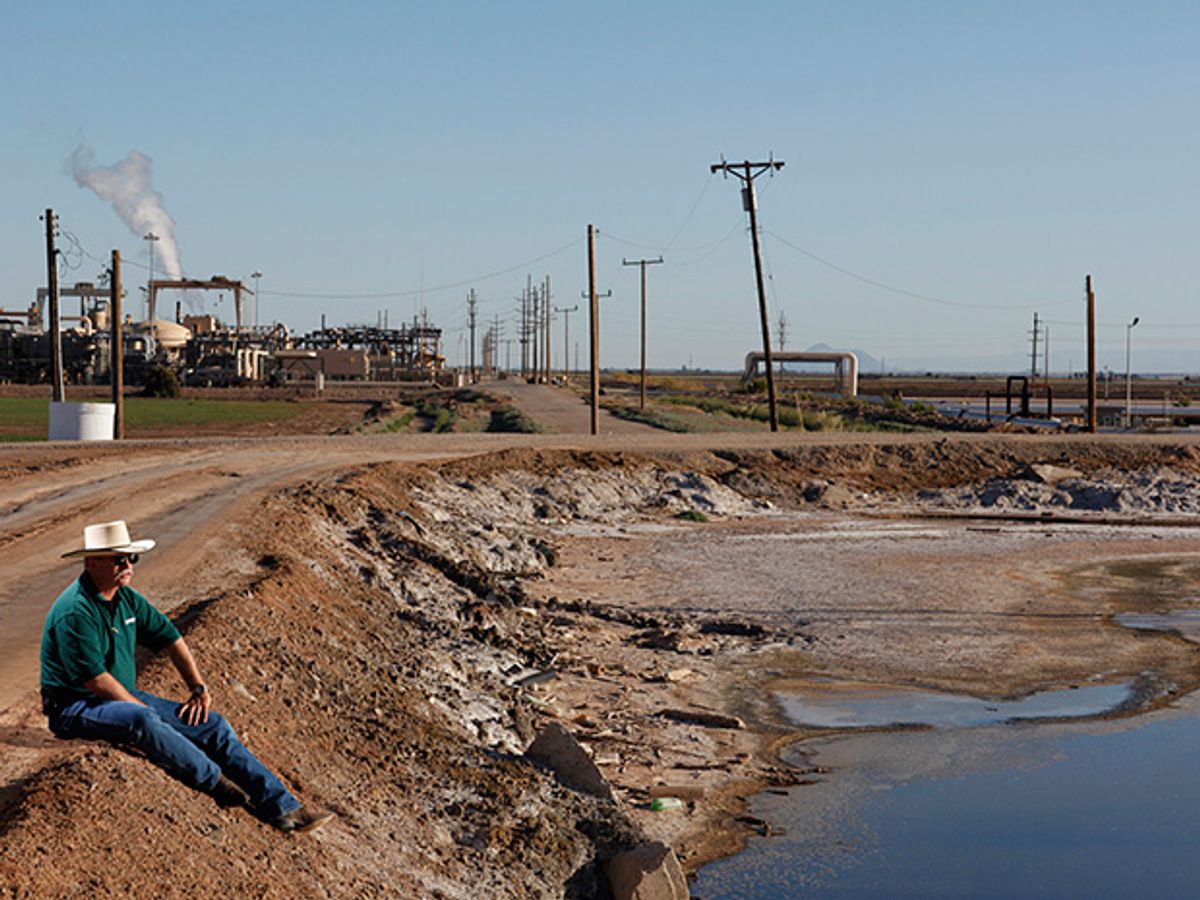
Mark Gran works for CalEnergy, a company that hopes to extract the geothermal bounty under the Salton Sea. But the company may see trouble as the water recedes.
At the edge of the Salton Sea, Mark Gran surveys the clanking, hissing labyrinth of pipes that curl up from the desert in the distance. In front of him, steam belches up from a geothermal plant's cooling towers, forming perfect puffy clouds that hang against a flawless blue sky.
“We got a lot of pots and pans," he shouts over the noise. Gran is a vice president at CalEnergy Generation, a company that's developing geothermal power in the Imperial Valley, in Southern California.
The 16 geothermal plants that dot the Imperial Valley—10 of which are owned by CalEnergy—are among the first signs of what California hopes will become a renewable-energy boom. Researchers from the U.S. Department of Energy's National Renewable Energy Laboratory estimate that fully exploiting a fault line beneath the Salton Sea would supply an astonishing 2300 megawatts of power, rivaling the output of a big nuclear power plant.
“This could be a great area for a renewable-energy hub," says Gran. “We just need water."
Beyond the plant, pipes reach out into the desert to bring water to the plants at the edge of the Salton Sea. For several reasons, the plants can't just take water out of the sea. Instead, they must get their water piped in from miles away. Without that water, this plant wouldn't make a watt. But CalEnergy isn't the first to tap into a water supply that doesn't naturally exist in these arid flats. A mere 20 minutes' drive from here, the dusty brown earth gives way to a vivid jolt of green: agricultural fields that cover thousands upon thousands of hectares of desert. Flanked by bare, sand-colored mountains, bearded date palms jut from geometric green fields.
The water that fills the pipes and feeds the fields comes from the Colorado River, which has been stretched, splintered, and redirected to bring water 2300 kilometers from the Rocky Mountains, where it begins as melting snowpack. The river ends in Mexico, but a network of canals as long as the river itself sends the Colorado's water coursing through the Imperial Valley's sloping fields, transforming this dry place into an unlikely agricultural powerhouse.
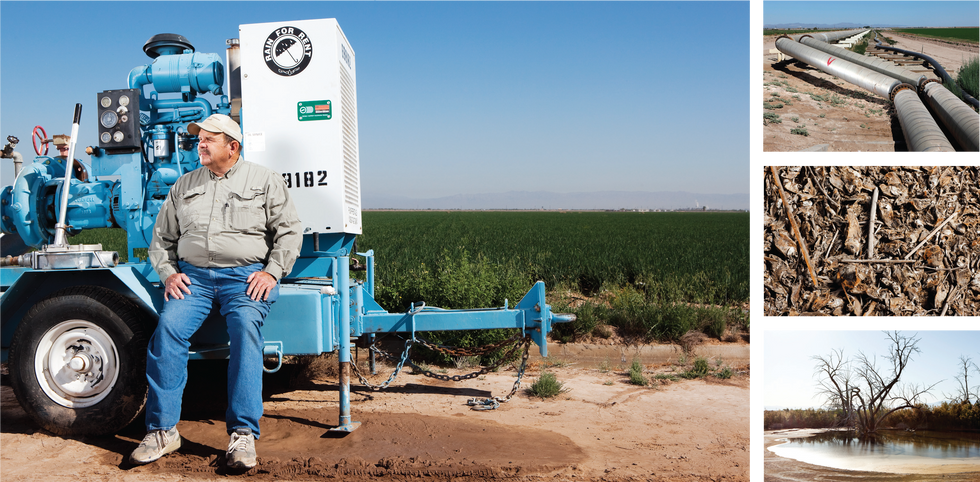
The Colorado, however, is also a vast hydroelectric machine that supplies the Southwest with much of its energy—directly, in the form of hydropower, or indirectly, by cooling massive thermoelectric power plants. “The more energy people need, the more water you need for power plants," says Mike Hightower, an engineer at Sandia National Laboratories who analyzes the competition between water and energy needs.
The intricate relationship between water supply and electricity generation plays out dramatically in the American Southwest. The problem its residents now face is a simple one of supply and demand. The Colorado is governed by agreements collectively known as the Law of the River, which divides up the rights to the water among seven states. The main provisions, set into law in 1922, have never been updated to reflect the region's rapid growth, and they now allocate more rights than there is water in the river. To complicate matters further, several prominent scientists predict that climate change will cause the river's flow to shrink considerably in the coming years. Tim Barnett and David Pierce, researchers at Scripps Institution of Oceanography, in La Jolla, Calif., say that those competing claims will reach a critical point by 2021. “Water deliveries will have to be cut even beyond the most draconian measures," says Barnett.
How that water will be shared will require some delicate rethinking. “People have a visceral reaction," says Patricia Mulroy, general manager of the Southern Nevada Water Authority. “You can take their gold, you can take their silver, their coal, gas, oil, and move it thousands of miles. Don't touch their water."
But the 30 million people who depend on the Colorado River will have no choice but to relinquish some of their supply because, simply put, there just isn't enough water for this growing population and its energy needs. The reasons can be found all along the Colorado's incredible reach, from the cracked deserts gasping for the river's final drops to the enormous reservoirs that showcase its shriveling might [see map, "The Colorado Machine"].
After irrigating the nation's butter lettuce and alfalfa in the Imperial Valley, the dregs of the Colorado River finally dribble into the Salton Sea. This quirky lake collects the last drops of the 3.8 million megaliters of water the valley gets each year.
The valley's water supply is nearly three-quarters of California's total share and enough for the daily needs of the nearby city of San Diego about five times over. Such abundance has never sat well with the residents of that city, which is in constant drought. “They saw water flowing into the Salton Sea," says Al Kalin, an Imperial Valley carrot and onion farmer. “They could really use it, and they thought we were wasting it."
In 2003, under pressure from the federal government, farmers scrambled to free up some water. The solution appeared simple: New conservation methods would enable the farmers to use less water, setting it aside for San Diego. The farmers did so, largely eliminating the runoff from their fields.
But less water for the valley meant less water to replenish the Salton Sea, which was already choking on fertilizer runoff and heavy metals that leached in from factories in Mexico. Fish died off in spectacular numbers. Kalin says that exotic algae became so abundant that just tossing a rock into the vile stew could ignite a brilliant splash of neon blue as the creatures glowed furiously in self-defense. “My grandchildren love the light show," he says. But Kalin had to stockpile scented candles to combat the stench.
The Colorado Machine
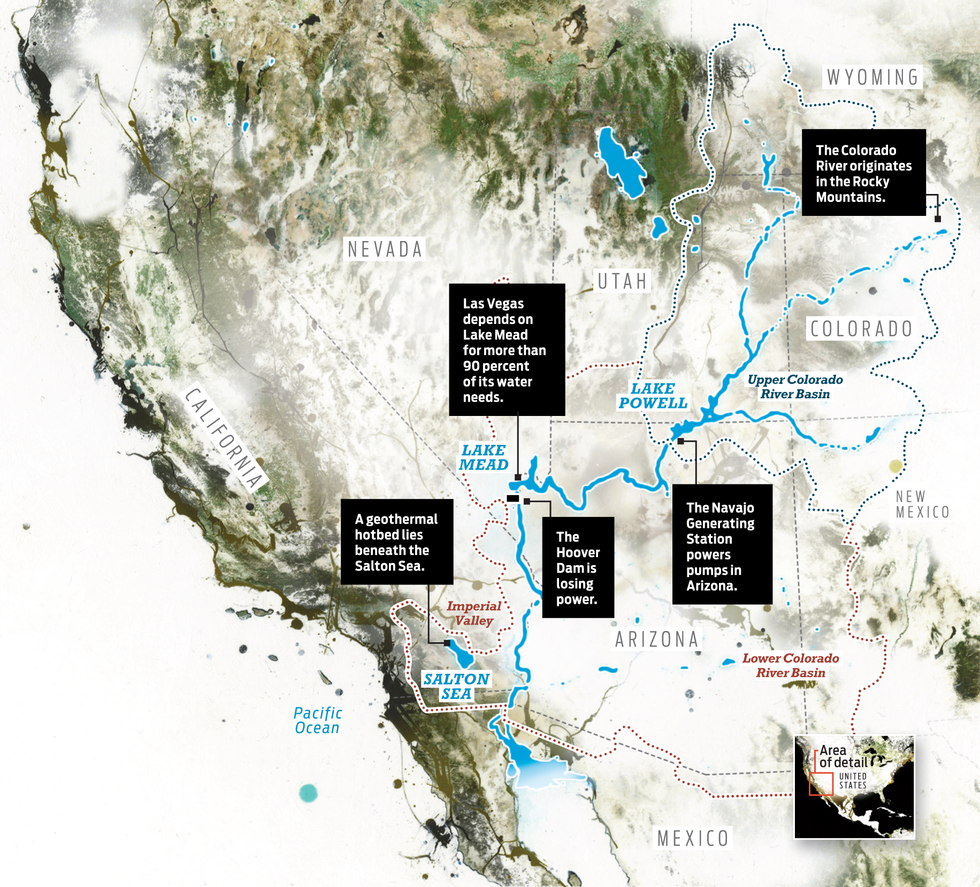
If that was bad, the lack of runoff has been even worse. Without the rivulets from the farms to sustain it, the lake will sink 1.8 meters a year in the desert heat. As it recedes, it exposes a fine silt containing sodium sulfate and selenium. The windstorms that frequently rip through the desert can stir up the selenium, which in humans can bring on neurological problems, cirrhosis, and in rare cases, death. Breathing in sodium sulfate can cause asthma attacks and other respiratory problems.
The Salton Sea's slow death also poses a major problem for the geothermal-energy industry and for the entire state of California. The state has set an ambitious goal of generating 33 percent of its electricity from renewable sources by 2020, and the Imperial Valley would play a big role in making that happen. That's because the major challenge in reaching that target is finding an ample supply of clean, reliable, round-the-clock power, and so far, only geothermal energy fills the bill.
If the lake continues to recede, the impending dust storms will endanger workers at the plants and damage their equipment. “The dust sure wouldn't be good for the turbines," says CalEnergy's Gran. The plants themselves, however, are partially to blame for draining the valley of its limited water supply, and therein lies the conundrum.
The Imperial Valley's geothermal plants use deep wells to tap into superheated rocks thousands of meters below the ground. In one approach, called flashing, the hot, pressurized brine that's trapped in those rocks surges to the surface. There, the pressure change causes some of it to turn to steam, which then drives turbines to generate electricity. Together, CalEnergy's flashing plants produce 342 MW, or enough to power about 250 000 homes.
Flashing plants need relatively little cooling water: Last year, all CalEnergy plants combined used about 4100 ML. However, flashing works only if the plant sits directly over the hottest part of the geothermal field, which in this case is right on the shores of the Salton Sea. And there's much more energy to be had further out in the valley.
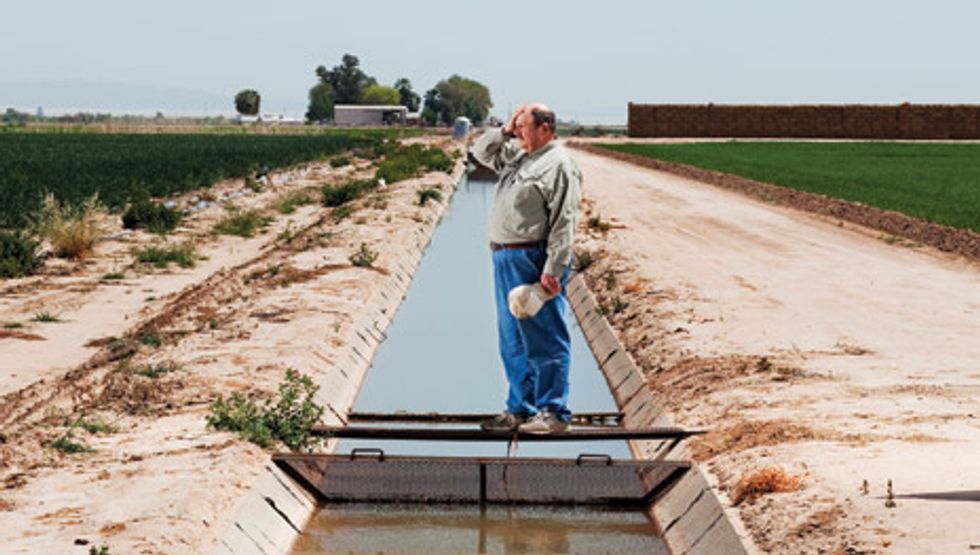
To fully harness the region's geothermal potential, prospectors will need a different type of plant, known as binary cycle. Because these can produce energy at lower temperatures, they can be built almost anywhere in the valley. Ormat Technologies operates three such plants. But there's a catch: Its 50-MW binary-cycle facility in Brawley, an Imperial Valley town about 25 km from the Salton Sea, uses over 7400 ML of water per year. That's about 57 Olympic-size swimming pools' worth per week and almost twice as much for one binary plant as CalEnergy uses for all 10 of its flashing plants. To generate steam, the hot brine vaporizes a chemical with a low boiling point, and the resulting vapor drives the turbines. Colorado River water then cools the chemical to condense it back into a liquid, completing the cycle.
No one knows where the water will come from to support the valley's growing geothermal presence. Ninety-seven percent of the water that reaches the Imperial Valley is promised by law to farmers. That leaves a mere 96 000 ML for all the valley's 160 000 residents and their businesses, and of this the geothermal industry has been given a third. “The little we use could be jeopardized if people need the water for farming or municipal uses," says Gran. “In a drought, how do you determine what takes precedence?"
To try to reconcile competing demands, the Imperial Irrigation District, which holds the valley's Colorado River water in trust, recently set tiered fees for the water in the hope that the higher price will let new prospectors extract the valley's geothermal energy without destroying the valley itself. New users who withdraw less than 1233 ML per year pay up to US $493 per megaliter. Those who use more must shell out three times as much. Whatever profit the district makes will go toward water-conservation projects.
Even the geothermal operators aren't convinced that the new pricing scheme will be enough to appease all the users and salvage the warped environment of the Salton Sea. Gran worries that the Imperial Valley lacks the political clout of a big city and that its water will continue to be taken, meaning more trouble for farmers and power producers alike. “The wolves are howling at the gate," he says.
The Imperial Valley's predicament begins far up the Colorado River at Lake Mead and Lake Powell, the two great reservoirs that make all this water wrangling possible.
The Law of the River allots 9.25 million ML of river water per year to each of two artificially designated basins. The upper basin consists of Colorado, New Mexico, Utah, and Wyoming, and the lower basin is made up of Arizona, California, and Nevada. To ensure that each basin gets its share, the U.S. Department of the Interior's Bureau of Reclamation uses Lake Mead and Lake Powell as water banks. The trouble is, there probably isn't 9.25 million for the lower basin, says Terrance Fulp, deputy regional director of the bureau's Lower Colorado region. For now, the numbers work only because some states, such as Utah and Wyoming, don't claim all their water. But the populations in those states are growing, and each will soon want to claim its full rights, says Scripps's Barnett.
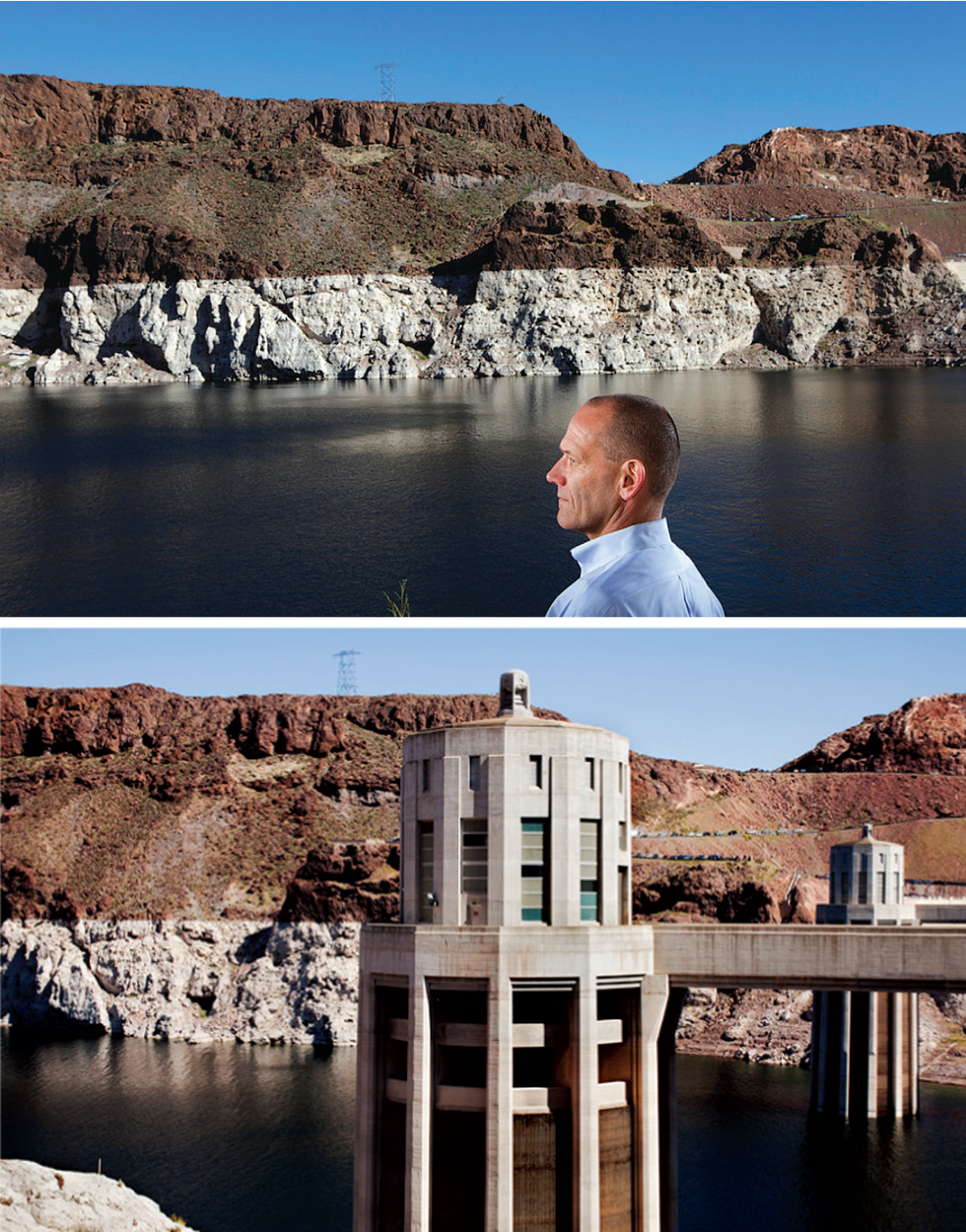
Without some new and extraordinary measures, that demand will be impossible to meet. The Hoover Dam, finished in 1936, halted the rushing river and created a placid water vault—Lake Mead. The lake is 372 meters deep when full, but that level hasn't been seen in 10 years. A drought that began in 1999 has caused the reservoir to drop more than 3 meters a year.
Today Lake Mead looks naked. The retreating water line has exposed a broad white stripe of calcite, a glaring “bathtub ring" that lends an air of vulnerability to the shrinking lake. “We used to go cliff diving all the time in Lake Mead," says a nurse in Henderson, Nev. “Now we wouldn't dare."
At press time, the elevation of Lake Mead hovered perilously around 335 meters. If the lake drops 8 more meters, the Bureau of Reclamation will sharply curtail water deliveries in a desperate bid to prevent the water level from sinking further.
When the reservoir is at normal elevations, Hoover Dam's 17 turbines have a combined generating capacity of 2080 MW. By February, the lake's decline had cut the dam's capacity by a fifth. But lower output is only the first symptom of an ailing hydroelectric system. When the lake level sinks and the pressure gets too low, air bubbles form on the turbine blades, and the generators start to shudder violently. “The magic number is 320 meters," says Hoover facilities manager Peter DiDonato. “That's when the turbines start to shake. You can feel it. The whole building will shake."
The vibration can damage the turbines to the extent that the engineers may stop production altogether. Shutting down the generators would be a huge blow to the three states that depend on the dam's power, and it's not an option that DiDonato likes to consider. “We just don't know, because we've never been there," he says.
The dam's stakeholders are now investing millions of dollars in new turbines that can function even at lake elevations that jeopardize the existing ones. Engineers plan to install the first such turbine in 2012. But new turbines alone won't solve the underlying problem. Lake Mead simply has less water than it did before, and that's a big concern for everybody who relies on the river.
More Water for Watts
.The Energy Information Agency predicts that the United States will add more than 70 gigawatts of thermoelectric capacity by 2030. The National Energy Technology Laboratory figures that this will increase the energy sector's water consumption from 2010's 9500 megaliters per day to between 10 600 and 11,700 ML per day. However, the new generation will be based on cooling technologies that consume (evaporate) more water but withdraw less, so the industry's total daily freshwater needs could fall by as much as 46 500 ML , a savings just shy of the Colorado River's historical average daily flow rate. Some of the technologies come out of a U.S. Department of Energy program aimed at developing three categories of commercial-ready technologies for existing plants that could cut their water use by 70 percent for half the cost of existing air-cooling technology.
Advanced Cooling
Air cooling radiates a
power plant's heat to the
air instead of evaporating
water. However, it's less
efficient than wet cooling,
especially in summer heat.
Air2Air, developed by SP X
Cooling Technologies, of
Overland Park, Kan., is an
add-on to a traditional
cooling tower that condenses
12 to 30 percent of
the water that is usually
lost to evaporation.
Reusing Water
Power plants can recirculate
cooling water
three or four times
before it becomes too
concentrated with
pipe-fouling minerals.
Engineers at
Philadelphia's Drexel
University want to
double that by blasting
the water with a high-voltage
pulse that
generates a mineral shattering
shock wave.
Nontraditional Water With the appropriate conditioning, water pushed out of the ground by the injection of carbon dioxide could be used to cool the power plant that produced the carbon dioxide in the first place.
Farther upstream, the energy problems are no less complicated. Before it reaches Lake Mead, the Colorado winds southwest across the top of Arizona from the river's other major reservoir, Lake Powell, situated on the border of Utah and Arizona. This lake was formed by damming the river at Glen Canyon and drowning the picturesque valley. The backed-up river filled in dozens of small gorges along its length, so from space the lake looks like a squashed centipede. But up close, it's beautiful—a sprawl of red-tinged buttes with verdant alcoves hidden among the cliffs.
On the Arizona side of the lake, near the town of Page, there is more evidence of what drought on the Colorado is doing to energy production. A pumping station pulls water from a brand new tunnel below the lake's surface to cool the Navajo Generating Station. The 2.25-gigawatt coal-fired plant located on the Navajo Nation reservation powers cities from Tucson to Los Angeles. It was built to provide electricity for the Central Arizona Project (CAP), a sprawling water distribution scheme that uses hundreds of pumps, canals, and dams to stretch the Colorado's water over much of Arizona. The CAP water travels 540 km from the California border, mostly uphill, with some of it being diverted along the way to Phoenix and Tucson, two of the country's fastest-growing cities. Navajo guzzles Colorado River water to cool the steam for its turbines, condensing the water for reuse in the plant's boilers. It's the pressure difference between the cooled condensate and the hot steam that drives the turbine.
Since the start of the Colorado's decadelong drought, Navajo's operators have worried about the security of their water supply. “We started to see Colorado River runoff drop to levels that no one had seen before," says Jim Pratt, the manager of generation engineering for Salt River Project, a southwestern water and power utility that owns a major stake in Navajo. Pratt and others calculated that if the drought continued, the power plant's inlet at Lake Powell would be sucking air by 2005, halting production. Thanks to a few closer-to-normal years of snow and rain, disaster didn't arrive so quickly. Lucky thing, too, because it took until last December to bore through the local sandstone and install a new inlet on the lake, 45 meters below the original.
The new water tunnel has bought the plant a margin of safety. But if Lake Powell shrinks even more, the plant's future will again be in peril.
The reduced hydropower from dams like Hoover and the possible loss of plants like Navajo mean electricity shortages in the West. Engineers at Argonne National Laboratory simulated the effects of drought on the Western grid and found that losing that water would increase electricity costs some $4 billion and leave a shortfall of 161 gigawatt-hours, enough to black out Los Angeles for two days. Electricity bills would rise as much as 34 percent in the summer, and because of the links between electricity and water—such as Navajo's role in slaking Tucson's thirst—higher water bills would likely follow.
The Argonne simulations used past droughts as a model, but if some climate models are to be believed, future shortfalls on the Colorado will be much worse. In a 2008 report, Scripps researchers Barnett and Pierce predicted that without intervention, Lake Mead has a 50 percent chance of running dry by 2021. Because the Bureau of Reclamation's Fulp will do everything in his power to prevent that, Pierce says, the real issue is what measures he will have to resort to.
Barnett and Pierce's analysis hinged on two main factors. First, human-induced climate change has reduced the amount of snow that feeds the river. That alone may be enough to bankrupt the system within two decades, Barnett says. The second factor has stirred up more controversy. According to several tree-ring studies from the University of Arizona, the river's flow during the 20th century was higher than it had been during the previous 150 years. So the people who divided up the Colorado River's water did so during the wettest part of a very wet cycle and mistakenly assumed that naturally occurring water supplies would remain the same. “They're planning on an average water flow in the Colorado that exists maybe once in a thousand years," says Barnett. “They're assuming money in the bank that they do not have."
Not everyone agrees with the Scripps scientists' predictions—notably Fulp. But some water managers are listening. “People argue with [Barnett and Pierce's] assumptions and probabilities," says Mulroy, who manages the water supply for Las Vegas, which depends on Lake Mead for over 90 percent of its water. “And I say, who cares what the probabilities are? Can you say it's impossible? And if it's not impossible, you'd better have a contingency plan."
This article appeared in the June 2010 print issue as "The Power of Water."


